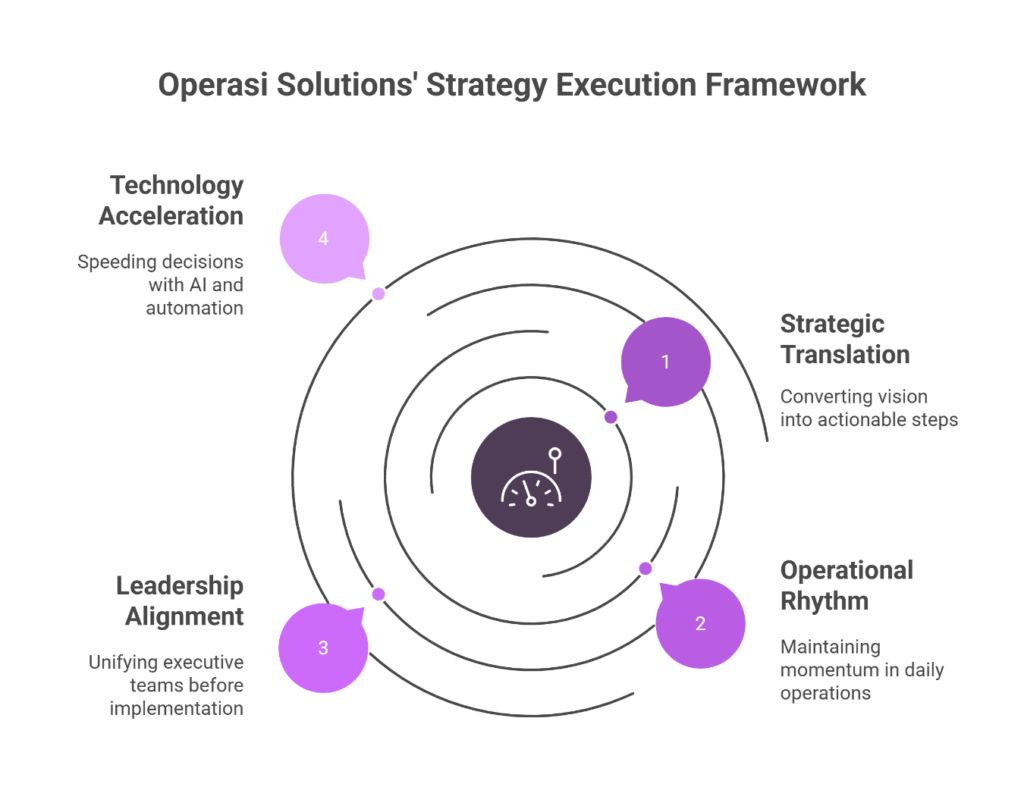Why Most Strategies Die in Execution — and How to Fix It
Former Fortune 500 executive reveals why strategies fail in execution and shares proven approaches that work. Real insights from boardroom to front lines.
I’ve watched too many brilliant strategies crash into reality and shatter.
The PowerPoint presentation looks flawless. The business case is airtight. The board gives enthusiastic approval. Then six months later, you’re standing in front of impatient investors explaining why the transformation is behind schedule and bleeding cash.
Sound familiar? It should. Most well-conceived strategies fail not because they’re wrong, but because something breaks down between the corner office and the factory floor.
After spending years leading complex transformations across aerospace, industrials, and infrastructure companies, I’ve seen this pattern play out repeatedly. The strategy isn’t usually the problem—it’s execution that kills good ideas.
Where Things Go Sideways
Five failure patterns show up so consistently, you could set your watch by them:
The Translation Gap
Executives speak in strategic themes while employees need specific instructions. “Digital transformation” sounds impressive in the boardroom, but it leaves people wondering whether they should update their software or completely redesign their workflow.
I once watched a “customer-centric transformation” stall for eight months because nobody could agree on what “customer-centric” actually meant in practice.
False Leadership Alignment
C-suite meetings end with confident handshakes, but when resources get tight, the unity dissolves. Sales pushes for growth investments. Operations demands efficiency upgrades. IT lobbies for stability. Without real alignment, these competing priorities strangle progress.
The worst part? Everyone thinks they’re supporting the strategy.
Complexity Blindness
Every transformation looks manageable from the executive suite. Then reality hits. Your supply chain spans six countries. The technology requires integrating systems that barely talk to each other. The culture change affects tens of thousands of people who’ve done things the same way for decades.
What seemed straightforward becomes a coordination nightmare that would challenge a military operation.
No Follow-Through System
Organizations excel at launching initiatives and fail miserably at sustaining them. Without regular check-ins, performance tracking, and clear accountability, even the most promising transformations fade into business as usual.
Good intentions don’t execute themselves.
Rigid Planning
Markets shift. Competitors adapt. Customer needs evolve. Yet many companies treat their strategic plan like religious doctrine—sacred and unchangeable. By the time they adapt to new realities, opportunities have vanished.
What Actually Works in the Real World
Companies that consistently execute well share five disciplines:
- Get ruthlessly specific about success. Replace vague objectives like “expand internationally” with concrete targets: “Establish profitable operations in Germany and Japan with local partnerships generating $50M annual revenue by Q4 2026.”
- Force genuine alignment upfront. Hash out resource conflicts and priority trade-offs in the C-suite before implementation begins. Surface disagreements early, not through passive-aggressive organizational warfare later.
- Build execution rhythm. Weekly leadership check-ins. Monthly performance reviews. Quarterly board updates. Consistent rhythm creates momentum and surfaces problems before they become crises.
- Make accountability everyone’s job. Whether through Lean principles, Six Sigma discipline, or Agile frameworks, embed follow-through into organizational DNA. Make keeping commitments part of company culture.
- Model the behavior you expect. When executives show up prepared, follow through on promises, and adapt when circumstances change, the entire organization mirrors that discipline.
Why Getting This Right Matters More Than Ever
In private equity environments, every delayed quarter erodes returns and partner confidence. In public companies, weak execution invites activist investors or regulatory scrutiny. Boards increasingly demand proof you can deliver results, not just develop strategies.
The leaders who thrive understand that having a strategy isn’t the competitive advantage anymore. Execution discipline is.
Our Approach to Closing the Gap
At Operasi Solutions, we tackle strategy execution through four integrated capabilities:
Strategic Translation: Converting high-level vision into specific, actionable steps that teams can execute without confusion or conflicting interpretations.
Operational Rhythm: Installing systems and processes that maintain momentum when initial enthusiasm fades and daily operations resume.
Leadership Alignment: Getting executive teams genuinely unified before implementation begins, not during the inevitable crisis when competing priorities surface.
Technology Acceleration: Leveraging AI-powered forecasting and automation to speed decisions and delivery without adding operational complexity.
Our P.E.A.K. framework and Summits of Leadership methodology emerge from years of directing transformations where execution discipline determined market position and competitive advantage.

Questions Leaders Ask About Strategy Execution
- Why do corporate strategies fail so often?
Most failures stem from the gap between strategic vision and operational reality. The strategy itself is usually sound—execution discipline is what’s missing.
- How long should transformation projects take?
Meaningful enterprise transformation typically requires 18-36 months, depending on scope and complexity. Anyone promising faster results probably doesn’t understand what’s involved.
- What makes boutique consulting different?
You work directly with executives who’ve actually run large organizations and led major transformations, not recent graduates following standardized methodologies.
- Which industries struggle most with execution?
Asset-heavy, complex industries—aerospace, industrials, infrastructure—face unique challenges due to long development cycles, regulatory requirements, and capital intensity.
- How do you diagnose execution problems?
When your strategy makes sense, your team is capable, but results consistently disappoint, execution discipline is usually the missing link.
- What’s the biggest execution mistake leaders make?
The Execution Advantage
Organizations that master execution discipline create sustainable competitive advantages. They respond faster to market changes, allocate resources more effectively, and build capabilities that strengthen over time.
More importantly, they develop leadership teams capable of translating any sound strategy into measurable business results—the capability that boards, investors, and stakeholders value most in today’s environment.
At Operasi Solutions, we believe execution is where strategy either succeeds or dies. That’s why execution is where our work begins.
